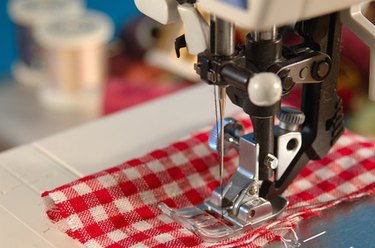Things You'll Need
Thread
Small sharp scissors
Small screwdriver
Brush canned air
Sewing machine oil

Pfaff sewing machines are designed to sew smooth even seams. If your machine is sewing uneven seams with skipped stitches or knots of thread underneath, troubleshoot your machine to fix the problem. First you will thoroughly clean and oil your machine then you will fine tune the tension. If this doesn't work you may be able to solve your problem by changing your needles and thread. A smooth running Pfaff sewing machine is a joy to work with.
Cleaning and Maintenance
Step 1
Turn off the master switch. Lift the pressure foot, raise the needle completely, open the bobbin compartment and remove the bobbin and the bobbin case. Remove any thread from the bobbin compartment using small sharp scissors if necessary. Thread here will completely stop your machine from operating.
Video of the Day
Step 2
Remove the needle and the pressure foot. Remove the screws that hold the needle plate in place and remove the needle plate. Clean the feed dog and the area under the needle plate with a brush and a blast of canned air. Lint in this area will cause the fabric to feed unevenly.
Step 3
Open the hook rack and pull the hook cover ring out toward you; remove the hook. Remove any thread from this area and clean with a brush and a blast of air. Put one drop of oil into the hook rack.
Step 4
Reassemble your machine with a new needle. Be sure the flat side of the needle is toward the back, the needle is fully inserted and the fixing screw is firmly tightened. A dull, bent or loose needle can cause the machine to skip stitches. This problem can also be caused by the wrong size needle or a machine that is not properly threaded. Also be sure the bobbin case is fully inserted. Sometimes these conditions will cause the needle to break.
Adjusting the Tension
Step 1
Wind a new bobbin and insert it in the case. Hold the bobbin thread close to the case and pull sharply upward. The bobbin case should drop down just a bit. If the case doesn't drop, the bobbin tension is too tight. Use a screwdriver to turn the screw on the case a little to the left to loosen the tension. If the bobbin case drops quickly 5 inches or more, the tension is too loose. Turn the screw a little to the right to tighten the tension.
Step 2
Sew a sample seam with a straight stitch. If the fabric puckers or the thread breaks, the thread tension is too tight. Loosen the thread tension.
Step 3
Sew a sample seam with a wide zigzag stitch and two pieces of fabric. Examine it. If the bobbin thread shows on the top, your thread tension is too tight. Adjust your tension to a lower number. If the top thread shows on the bottom, the thread tension is too loose. Set your tension to a higher number. Adjust the tension until the top and bobbin threads interlock between the layers of fabric. If this does not work, clean your tension disks.
Step 4
Cut a piece of thread 1 1/2 yards long. Double it twice until you have four strands. Tie a knot in the middle. Use this hank of thread to clean both sides of the tension disks.
Step 5
Wrap the ends of the thread around your forefingers. Hold your hands above and below the tension disk and pull the knot back into the thread slot. Pull the knot up and down through the tension disks to clean out any thread or lint between the disks. Repeat for the other side of the disks. Readjust your tension.
Solving Accessory Problems
Video of the Day
Step 1
Check your thread spool for rough edges which could cause the thread to catch and the machine to stop. You can often solve this problem by turning the spool over.
Step 2
Replace your thread in the top and the bobbin with new high quality thread. Old thread is weak and breaks easily. Low quality thread is uneven and catches on everything.
Step 3
Use sharp straight system 130/705 H needles. If your needles are the wrong size or dull or bent they will not function properly. Be sure your needle eye is large enough for your thread. Check your instruction book and the needle package for the proper needle for your project.
Step 4
Be sure your machine is threaded properly and all parts are firmly in place.
Step 5
Take your machine to an authorized Pfaff repairman for further troubleshooting and a tune up if it still is not working properly.
Tip
Details for removing the various parts will vary by machine model. Consult your instruction manual.
Warning
Use only one drop of oil. Only oil your machine once every 15 to 20 hours of operation. Too much oil will stain your fabric. If you have too much oil you can only solve the problem by gently blotting any visible oil with a soft lint-free cloth and then sewing lots of seams on lint-free scrap fabric with cotton thread in the top and bobbin.